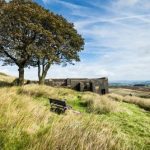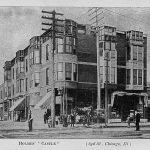 Crime
Crime  Crime
Crime  Humans
Humans 10 Unsung Figures Behind Some of History’s Most Famous Journeys
 Animals
Animals 10 Species That Refused to Go Extinct
 Weird Stuff
Weird Stuff 10 Weird Things People Used to Do at New Year’s
 Our World
Our World 10 Archaeological Discoveries of 2025 That Refined History
 Weird Stuff
Weird Stuff 10 Fascinating Facts You Might Not Know About Snow
 Miscellaneous
Miscellaneous Top 10 Things Crypto Was Supposed to Change & What Actually Did
 History
History 10 Huge Historical Events That Happened on Christmas Eve
 Music
Music 10 Surprising Origin Stories of Your Favorite Holiday Songs
 History
History 10 Less Than Jolly Events That Occurred on December 25
 Crime
Crime 10 Dark Details of Australia’s Gruesome Unsolved Wanda Murders
 Humans
Humans 10 Unsung Figures Behind Some of History’s Most Famous Journeys
 Animals
Animals 10 Species That Refused to Go Extinct
Who's Behind Listverse?

Jamie Frater
Head Editor
Jamie founded Listverse due to an insatiable desire to share fascinating, obscure, and bizarre facts. He has been a guest speaker on numerous national radio and television stations and is a five time published author.
More About Us Weird Stuff
Weird Stuff 10 Weird Things People Used to Do at New Year’s
 Our World
Our World 10 Archaeological Discoveries of 2025 That Refined History
 Weird Stuff
Weird Stuff 10 Fascinating Facts You Might Not Know About Snow
 Miscellaneous
Miscellaneous Top 10 Things Crypto Was Supposed to Change & What Actually Did
 History
History 10 Huge Historical Events That Happened on Christmas Eve
 Music
Music 10 Surprising Origin Stories of Your Favorite Holiday Songs
 History
History 10 Less Than Jolly Events That Occurred on December 25
10 British Houses with Insane Literary Connections
Ever since Geoffrey Chaucer picked up his quill in the late 1300s, scratched his chin thoughtfully, and declared that he would write The Canterbury Tales in English instead of French or Latin, Great Britain has been producing incredible writers.
From the sublime poetry of William Shakespeare to the witty banter of Jane Austen to the wild romance of Emily Brontë, we have been hooked. But have you ever wondered where these great works of art were written? Which garden did Thomas Hardy gaze out at as he conceived of Bathsheba Everdene? Which genteel parlor inspired Agatha Christie to have some fun with murder most foul? Which landscapes and fireplaces were closest to our favorite writers’ hearts?
Luckily, Britain is well-practiced at preserving its historical landmarks. All ten of the houses in this list still stand today, preserved by people passionate about literary heritage, and many of them are open to visitors.
Related: 10 Criminal Writers With Real Skeletons In Their Closets
10 Chawton Cottage—Jane Austen
It’s crazy to think that Jane Austen left us with only six finished novels. Her unique blend of sparkling wit and social commentary has captured the minds and hearts of countless readers over the last two hundred years. In fact, her work has never been out of print—not bad for the humble daughter of a clergyman!
Austen never married, and she didn’t own a house. Unfortunately, she lived during a time when unmarried women were financially dependent on the men in their families. In 1809, her brother Edward took pity on her, allowing her to move into one of his properties in a picturesque village in Hampshire. Along with her beloved sister Cassandra, Austen called Chawton Cottage home for the next eight years until her death in 1817.
From her writing desk in the back parlor, this obscure and penniless woman created characters we have loved, loathed, and laughed at for two centuries. Just think. The mind that gave us Mr. Darcy lived, breathed, ate, and slurped tea in those very rooms. Hallowed ground![1]
9 Hill Top—Beatrix Potter
A beloved children’s writer and illustrator, Beatrix Potter is perhaps most famous for her adorable creation Peter Rabbit. Amazingly, she was able to purchase her home Hill Top following the success of her very first story, The Tale of Peter Rabbit, in 1905.
Hill Top is a 17th-century farmhouse in the charming town of Ambleside, in the Lake District. It is surrounded by lush greenery and beautiful flowers. Potter treasured the place as a much-needed retreat, allowing her to reconnect with nature and feed her fertile imagination. In fact, just being there feels like stepping into one of her lovely stories![2]
8 48 Doughty Street—Charles Dickens
Charles Dickens is the quintessential Victorian. Photos of the novelist present an imposing figure—bearded and serious, with a cane and a starched collar. But despite his somewhat austere appearance, Dickens was a kind and empathetic man who cared deeply about the poor.
Dickens’ first novel, The Pickwick Papers, was so successful it allowed him to buy his first home at 48 Doughty Street in London. The property is now a popular museum, celebrating the author’s life and writing and hosting various literary exhibitions.
The purchase of such a fine house would have been a huge personal achievement for Dickens, who was born into a struggling working-class family and knew hardship from an early age. When he was twelve, his father was thrown into prison for failing to pay outstanding debts, and Dickens was forced to work in a factory for a year. Victorian factories were difficult, unforgiving places, and the experience profoundly affected him.
As a result, Dickens’s novels are filled with searing social commentary, along with empathetic and humane depictions of the poor and needy in society.[3]
7 Monk’s House—Virginia Woolf
A famous member of the Bloomsbury Group in London, Virginia Woolf was a fiercely intelligent and complicated woman who surrounded herself with writers, artists, and forward thinkers. In a time of social and sexual restraint, she lived her life according to her own rules, famously having an affair with another woman, Vita Sackville-West. She also battled mental illness throughout her life.
Woolf bought the 16th-century cottage Monk’s House in 1919 with her husband, Leonard. It is a peaceful and picturesque place, with ponds and an orchard, surrounded by the charming Sussex countryside. The cottage and grounds are open to visitors, where you can learn about Woolf’s life and the activities of the Bloomsbury Group.[4]
6 Hardy’s Cottage—Thomas Hardy
Thomas Hardy is famous for his spunky working-class heroines and depictions of the hardships of rural life, so it’s no surprise that his family home was a charming, thatched cottage in the Dorset countryside.
The cottage had been in the family for generations before Hardy inherited it, having been built years before by his great-grandfather. Hardy himself was born there in 1840. He wrote several of his most famous books there, including Far from the Madding Crowd. Just outside the cottage is Thorncombe Woods, where the Hardy family would collect logs for the fire.
These days the cottage is owned by the National Trust and preserved in Hardy’s memory. In fact, if you visit today, you can sit in the very room where he wrote his books![5]
5 Shakespeare’s Birthplace—William Shakespeare
The father of modern English literature was born in a cottage in Stratford-Upon-Avon in 1564. His father, John Shakespeare, was a glovemaker and respected businessman. As far as we know, Shakespeare didn’t write any of his plays under this roof, as he spent most of his adulthood in London mingling with the theatre crowd. We do know that he inherited the house when his father died, and his own three children were born there.
He must have been fond of Stratford-Upon-Avon, though, because he put roots down there in 1597 when he bought his first house, “New Place,” a few streets away. He lived in this house for 19 years and died there in 1616. Sadly, New Place no longer exists, but a garden has been built on the site to commemorate it.[6]
4 Greenway—Agatha Christie
Ahh, Agatha Christie. The very name conjures up images of village fetes, gossiping old ladies, and afternoon tea in the parlor. Christie is a legend, and her timeless mysteries somehow manage to feel vaguely threatening and infinitely cozy all at the same time.
Greenway in Devon was Christie’s beloved holiday home, where she and her extended family would gather to spend weeks together enjoying the elegant house and lush surroundings. It’s exactly the sort of place where you can imagine one of Christie’s murders taking place, with portrait-lined hallways, a stylish drawing room, and a cozy library.
It’s no surprise that Agatha is officially the best-selling author of all time—her whopping 78 novels have been translated into 44 languages, and around two billion copies have been sold. All hail the undisputed queen of middle-class murder![7]
3 Haworth Parsonage—The Brontë Sisters
The Brontës were a weird and wonderful bunch. Sisters Charlotte, Emily, and Anne grew up in the northern village of Haworth—a quaint, picturesque little place edging onto the wild Yorkshire moors. Their mother died of cancer in 1821, and they had two older sisters, Maria and Elizabeth, who sadly both died of tuberculosis a few years later.
As their father was a clergyman, the sisters grew up in the village parsonage. Along with their brother, Bramwell, they spent their quiet and isolated childhood entertaining one another with stories. But life was hard, and tragedy was never too far away. Bramwell died of tuberculosis at age 31. Emily passed away not long after. Anne died in the seaside town of Scarborough while working as a governess, still in her twenties. That left Charlotte, who lived until she was 38. Sadly, their father outlived all his children.
The Brontë Parsonage is now a museum open to visitors, as is the nearby school room where Charlotte worked as a teacher.[8]
2 Abbotsford—Sir Walter Scott
When Sir Walter Scott first bought this property in 1811, it was a modest farmhouse on a river bank near the Scottish town of Melrose. After expanding the grounds and planting numerous trees, Scott turned his attention to his living quarters. He demolished the farmhouse and replaced it with the grand, imposing, and castle-like structure we see today.
The inside of Abbotsford is exactly how you’d expect the home of a Romantic novelist to look—all mahogany paneling, imposing bookshelves, and suits of armor. Most of the rooms have been preserved since his death, and you can look around them before taking a turn about the woodland paths Scott designed himself. A whopping 120 acres are still preserved by the Abbotsford Trust![9]
1 Villa Diodati—Mary Shelley
Okay, I’m cheating a little—the Villa Diodati isn’t in Britain. The imposing, privately owned villa is situated on the shores of Lake Geneva in Switzerland. It is about as far from the cozy cottages and charming townhouses contained in this list as you can get. Still, the story of Shelley’s stay there, in the summer of 1816, is so legendary it had to be included.
Shelley was at the villa visiting the Romantic poet Lord Byron and his physician, John Pilidori. During her stay, the weather deteriorated, and the group was snowed in. None of them imagined this period of house arrest would make literary history. But it did.
The fierce storms and desolate landscape must have had quite the effect on the villa’s inhabitants because Lord Byron challenged the group to each write a ghost story, and they all agreed. Shortly afterward, Shelley had a nightmare about a crazed scientist building a person out of body parts. She turned this dream into her ghost story and expanded upon it—and a literary sensation was born.
Unbelievably, Shelley’s visit to the Villa Diodati took place when she was only 18—and the subsequent publication of her first novel, Frankenstein, inspired by the experience, took place when she was 20![10]








